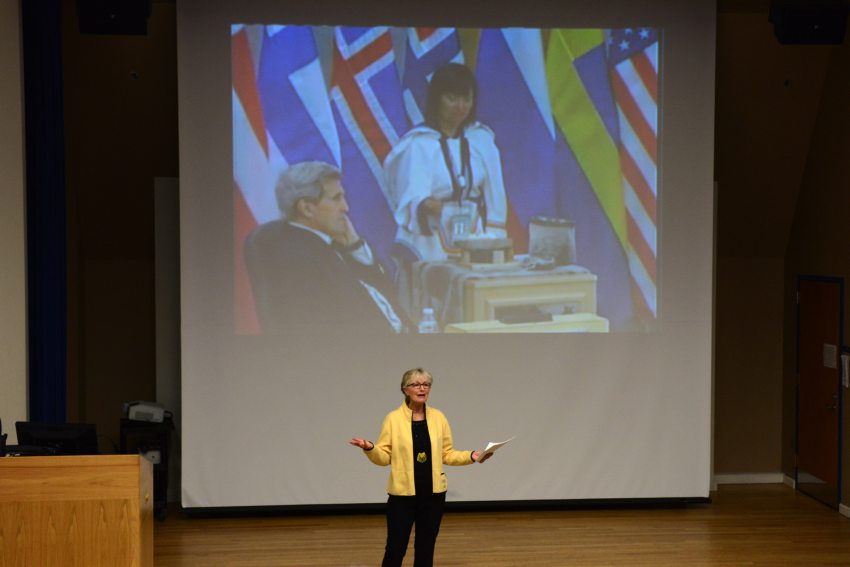Arctic Council uses Fairbanks meeting to think about the future

Midway through the U.S. chairmanship of the eight-nation Arctic Council, the group is taking time to look at the long-term future of the world’s northernmost region – and itself.
David Balton, the State Department official who chairs the Arctic Council’s Senior Arctic Officials group, said on Friday that council leaders used this week’s meeting in Fairbanks to look beyond the two-year U.S. chairmanship.
“I got the Arctic Council to take a step back from its day-to-day work and think about the longer term,” he said at a press briefing at the University of Alaska Fairbanks, the meeting site for the Arctic Council SAOs and working groups, the Arctic Summit Science Week and related events.
The longer-term view included a “fairly extraordinary discussion” about what the Arctic Council might do differently about climate change in the wake of last December’s Paris climate agreement, Balton said. Even if the Paris commitment of no more than a 2-degree Celsius increase in the global temperature is achieved, the Arctic has already warmed more than that and will continue its accelerated warming, he said. So the council’s senior officials are looking at what the council might do in the next five to 20 years, he said.
“How can we help local communities adapt to climate change in the North? What does it mean for the rest of the planet?” he said.
Strategic plan
This week’s work also included launch of a “long-term strategic plan,” which some Arctic Council working groups have had but that the council as a whole has never had in its 20-year history, Balton said.
“I believe we need such a plan,” he said. It would help set priorities and provide “yardsticks against which to measure our progress more easily.”
In addition, the long-term focus this week turned to money. Balton said there was talk of increased funding or, at least, steadier funding for the council’s work. Up to now, funding has been largely ad hoc, with different groups contributing for different projects, he said, but there are ambitions to change that.
“You can’t always plan very easily if you don’t know what the funding stream’s going to look like three, four years down the road. At a minimum, I think we need to move to a world where the funding for the Arctic Council becomes more predictable,” he said
The council’s operations are fairly inexpensive, with only about $1 million needed for annual administrative functions, Balton said. Spending on the projects is more difficult to quantify, as there are contributions from governments and other entities, including in-kind contributions, he said.
In the shorter term, some projects are expected to wrap up next year, when the U.S. hands over chairmanship to Finland at a ministerial meeting to be held in Fairbanks.
One project, started prior to the U.S. chairmanship, is the creation of a binding agreement among Arctic states to promote scientific research.
“That effort is coming to fruition as we speak,” Balton said. “My expectation is that a year from now, the eight ministers of the Arctic will have pens in their hands and sign this agreement when we come back here in Fairbanks. The idea behind this agreement is to break down barriers that still remain, unfortunately, to the conduct of scientific research throughout the Arctic. “
Technology, energy & health
Other projects underway and mentioned by Balton include creation of an academy to study and install renewable-energy technology in remote areas, including rural Alaska; an expansion of the Alaska Native Tribal Health Consortium’s Local Environmental Observer network, which the council is now trying to make circumpolar; establishing a network to exchange information and science among protected marine areas around the Arctic; and projects to identify and reduce sources of black carbon in the Arctic, which darkens snow and ice and hastens melt and warming.
Balton said good progress has been made on one important U.S. priority, which is to raise awareness of the Arctic in the more southern parts of the world.
It may not be such a big challenge for each of the other seven Arctic nations, for which “a big part of their identity is being a northern country, being an Arctic country,” he said. Not so in the United States, he said: “Yes, here in Alaska that’s quite obvious, but in the Lower 48, not as much.”
That goal got a big push six months ago, he said, when President Obama came to Alaska to attend the State Department’s GLACIER conference in Anchorage and travel to rural areas, including the Arctic.
“Probably the single biggest thing that happened to help bring the attention of the Arctic to the people of America as a whole was the visit of our president to Alaska here last summer,” he said. “The attention and the media that followed really helped to make real for a lot of Americans the situation of Alaska, the profound and enduring interest of our nation in the Arctic region as a whole and I think may lead to more funding for Arctic issues. So that’s my hope.”
The Lower 48 will get more opportunity to focus on Arctic issues in October, when the council’s SAO group convenes in Portland, Maine. The Maine setting came at the suggestion of one of that state’s senators, Angus King, who has collaborated with Sen. Lisa Murkowski to form a Senate Arctic caucus.
Related stories from around the North:
Canada: The Arctic Council’s capacity challenge, Blog by Heather Exner-Pirot
Iceland: Iceland blasts Arctic Five for exclusion from fishing agreement, Eye on the Arctic
Norway: Arctic Council aims to boost business, Barents Observer
Sweden: Arctic Council – From looking out to looking in, Blog by Mia Bennett, Cryopolitics
United States: How many observers can Arctic Council handle?, Alaska Dispatch News



